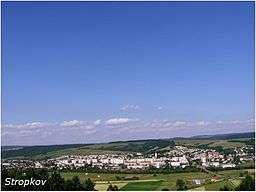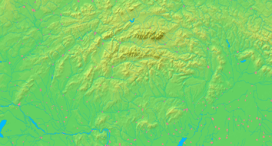Stropkov
| Stropkov | ||
| Town | ||
 View of Stropkov | ||
|
||
| Country | Slovakia | |
|---|---|---|
| Region | Prešov | |
| District | Stropkov | |
| River | Ondava | |
| Elevation | 202 m (663 ft) | |
| Coordinates | 49°12′18″N 21°39′05″E / 49.20500°N 21.65139°ECoordinates: 49°12′18″N 21°39′05″E / 49.20500°N 21.65139°E | |
| Area | 24.667 km2 (9.524 sq mi) | |
| Population | 10,866 (2012-12-31) | |
| Density | 441/km2 (1,142/sq mi) | |
| First mentioned | 1404 | |
| Mayor | JUDr. Ondrej Brendza | |
| Timezone | CET (UTC+1) | |
| - summer (DST) | CEST (UTC+2) | |
| Postal code | 091 01 | |
| Area code | +421-54 | |
| Car plate | SP | |
  Location of Stropkov within Slovakia | ||
  Location of Stropkov within the Prešov Region | ||
| Wikimedia Commons: Stropkov | ||
| Statistics: MOŠ/MIS | ||
| Website: www.stropkov.sk | ||
Stropkov (Slovak pronunciation: [ˈstropkow]; Hungarian: Sztropkó, pronounced [ˈstropkoː], Yiddish: סטראפקאוו) is a town in Stropkov District, Prešov Region, Slovakia.
History
Stropkov is an economical, social and cultural centre of north Zemplín. It was established on left bank of river Ondava in beautiful scenery of central part in Ondava uplands. For its origins as an ancient Slovak settlement we have to look back (and many archaeologists and historians agree in this case) before the 13th century. The character of the main square is a proof that Stropkov used to belong to the royal lands and there are also some similarities with the development of another town, called Bardejov.
The first authentic written data about the town is from 1404 (Stropko), when Stropkov was already labeled as oppidum—townlet. German guests and soltys too were obtained with the same privileges as their fellows in Bardejov and other towns. The first owner of the town after the king was Ladislav Svatojursky. The other landlords in order were Balickovci, Perinskovci, Peteovci. In 1408 town's toll and castle—castellum—were mentioned for the first time. The development of the town and its whole economic expansion was supported by the law of thirty and market in 1698 which was strengthened by Leopold I with six annual fairs. Stropkov's manor owned about 51 villages in that time. The existence of a big department, which articles dated back in 1575 was an extraordinary event in the history of Slovakia. In this department many different people were united, for example: jewelers, tailors, butchers, cabinetmakers, saddlers, swordfishes, surgeons (shavers) and shopkeepers. Craftsmen from Stropkov were known not only in their hometown, they were selling their products in markets of towns in regions like Zemplin and Šariš as well.
In the process of successful development, Stropkov was touched by status’ rebellions of Imrich Thokoly and Francis II Rákóczi. We can easily deduct this fact from region list from year 1715, where it is written that in Stropkov in that times lived only 7 bourgeoises who did pay taxes. In 1764 Peteovci family died out, manor was divided into 6 parts, including Staraiovci, Hallerovci, Keglevicovci, Dezofiovci, Veceiovci and Barkociovci. In 1785 about 204 houses and 1326 inhabitants were to found in the town. Stropkov was the third town with the most numbers of residents in the Zemplin region with 87 craftsmen (year 1778) and it was the second important craftsman centre after Humenné town. In that period it became a residence of Zemplin chair. This situation lasted in next few years: 1848, 1918 and 1945, up until 1960. Since the 18th century the town started to decay. In 1828 there were 201 houses and 2250 inhabitants. Many other numbers speak about the evident stagnation: in 1869 used to live there 2502 inhabitants while in 1900 only 2276. After 1870 we can speak about mass emigration of native people who were moving abroad.
During the time between wars Stropkov and its district belonged to one of the most underdeveloped and poorest regions in Slovakia. Besides agriculture, the living was earned by traditional craft industry and works in woods. In the years of the Second World War economical decline was fully in progress. Only 487 houses with 3311 inhabitants were filling the territory of Stropkov during the wartime. Besides the complicated after war situation it is visible that the construction of Tesla factory and many other firms have had an important contribution to essential changes in demography and in infrastructure. When only 2695 people in 1950 lived in town, in 1991 there were already 9719 people to be found.
The first written information about the school is from 1515, but indisputably the school was there a little bit sooner—in the previous century. In 17th century Franciscans came to the town and in 1921 the first redemptorist cloister was founded.
The remains of the castle are situated in the storied building that occupies the east side of the church. Roman Catholic church, called The Holy Body of Jesus Christ, comes from 14th century. In 1675 it was restored and supplemented with a Gothic castle chapel. The inside Baroque decoration is from 18th century. Uniate cathedral was built in 1947, Jewish synagogues have not been preserved.
Only 20 kilometres (12 miles) away from Stropkov is located a most attractive place to relax—the Domaša reservoir. The nearby village of Tokajík is famous for the memorial of victims who died in the Tokajík tragedy in 1944.
Jewish community
Jews first arrived in Stropkov, possibly fleeing Polish pogroms, in about 1650. About fifty years later, the Jews were exiled from Stropkov to Tisinec, a village just to the north. They did not return to Stropkov until about 1800. The Stropkov Jewish cemetery was dedicated in 1892, after which the Tisinec cemetery fell into disuse.
In 1939 the antisemitic Hlinka Party gain control of the Stropkov Town Council. From May–October 1942 the Hlinka deported Jews from the Stropkov area to Auschwitz, Sobibor, Maidanek, and "unknown destinations". By the end of World War II, only 100 Jews remained in Stropkov out of 2000 in 1942.
Chief Rabbis of Stropkov
The first rabbi of Tisinec and Stropkov was Rabbi Moshe Schonfeld. He left Stropkov for a position in Vranov. He was succeeded in 1833 by Rabbi Yekusiel Yehudah Teitelbaum (I) (1818–1883) who served as Stropkov's chief rabbi until leaving for a post in Ujhely. The next incumbent was Rabbi Chaim Yosef Gottlieb (1790–1867), known as the "Stropkover Rov". He was succeeded by Rabbi Yechezkel Shraga Halberstam (1811–1899), a son of Rabbi Chaim Halberstam of Sanz. His scholarship, piety, and personal charisma transformed Stropkov into one of the most respected chasidic centers in all Galicia and Hungary. Rabbi Moshe Yosef Teitelbaum (1842–1897), the son of the aforementioned Rabbi Yekusiel Yehuda Teitelbaum, was appointed as Stropkov's next chief rabbi in 1880.
The charismatic and scholarly Rabbi Yitzhak Hersh Amsel (c1855–1934), the son of Peretz Amsel of Stropkov, was first appointed as a dayan in Stropkov and then as the rabbi of Zborov (near Bardejov). As legend has it, Rabbi Yitzhak Hersh Amsel died while praying in his Zborov synagogue. He is buried in the Stropkov cemetery where a small protective building ohel was erected over his grave to preserve it. Rabbi Amsel was succeeded in 1897 by Rabbi Avraham Shalom Halberstam (1856–1940). Jews, learned and simple alike, sought the advice and blessing of this "miracle rabbi of Stropkov", revered as a living link in the chain of Chassidus of Sanz and Sienawa. Rabbi Halberstam served in Stropkov for some forty years, until the early 1930s, when he assumed a rabbinical post in the larger town of Košice. Rabbi Menachem Mendel Halberstam (1873–1954),the son of the aforementioned Rabbi Avraham Shalom Halberstam was then appointed chief rabbi of Stropkov and head of the Talmud Torah. After World War II Rabbi Menachem Mendel Halberstam lived in New York until the end of his life, teaching at the Stropkover Yeshiva, which he founded in Williamsburg, Brooklyn.
The present day Admor of Stropkov is HaRav Avraham Shalom Halberstam of Jerusalem. The Admor runs several yeshivas and kolelim in Jerusalem and other cities in Israel. The Admor dedicates himself to Ahavat Yisrael and to helping many who need to return to their Jewish roots.
International relations
Twin towns — Sister cities
Stropkov is twinned with:
Famous people
Notable people from Stropkov include the footballers Juraj Čobej and Ľuboš Reiter, referee Ľuboš Micheľ, singers Marika Gombitová and Beáta Dubasová.
Institutions
- Schools
- Library
- Offices
- TIC – Tourist Information Centre
- Association for people with mental illness www.domdeti.sk
Factory
- Tesla, a.s. Stropkov www.tesla.sk/sk
Most important monuments
- Roman Catholic Gothic church (14th - 15th century) www.rkfustropkov.sk
- Stropkov Castle www.restauraciakastiel.com
- Church of St. Francis
- Gothic and Renaissance châteaux
Culture and interests
- Zoopark www.zoostropkov.sk
- Newspaper Spektrum www.espektrum.sk
- The oldest pilgrimage site in Slovakia in honor of Our Lady of Carmel / Scapulary - The Brotherhood of the Holy Scapular in the Roman Catholic Church of the Most Holy Body and Blood of Christ in Stropkov 05.11.1669 approved the bull of Pope Clement IX .. Saints-day is held every year on the date 7/16 ..
References
Bibliography
- Amsel, Melody (2002). Between Galicia and Hungary: The Jews of Stropkov. Bergenfield, NJ.
- Weinstein, Avraham Abish (1968). ספר זכרון סטראפקוב (Stropkov Memorial Book). Brooklyn.
Notes
- ↑ "Ropczyce - Miasta Partnerskie". Urząd Miejski Ropczyce (in Polish). Archived from the original on 2012-09-22. Retrieved 2013-08-01.
